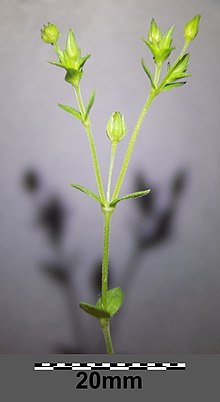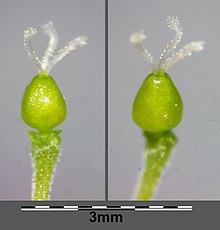Common sandwort
| Common sandwort | ||||||||||||
|---|---|---|---|---|---|---|---|---|---|---|---|---|

Common sandwort ( Arenaria serpyllifolia ) |
||||||||||||
| Systematics | ||||||||||||
|
||||||||||||
| Scientific name | ||||||||||||
| Arenaria serpyllifolia | ||||||||||||
| L. |
The Quendel Chickweed ( Arenaria serpyllifolia ), also Quendelblättriges Chickweed or lemon thyme Chickweed called, is a plant from the genus of arenaria ( Arenaria ) within the family of Caryophyllaceae (Caryophyllaceae).
description
Appearance and leaf
The sandwort is a small annual or biennial herbaceous plant that usually reaches heights of about 10 to 15 centimeters, sometimes up to 30 centimeters. The mostly upright stem is mostly strongly branched from the base.
The opposite leaves are ovate and pointed at the front. They are slightly wider than most of the species in the genus. Like the other parts of the plant, they are short and coarse with hair. The plant therefore often has a gray-green color. The stem sections between the leaves are significantly longer than the leaves, so they are at a distance.
Inflorescence, flower and fruit
The short-stalked flowers are grouped into several in a clearly separated inflorescence. The flowering period extends from May to September, with only a few flowers open at the same time. The relatively small, hermaphrodite flowers are radial symmetry and five-fold with a double flower envelope . The five green sepals are about 3 to 4 millimeters long and have a white, membranous border on the edge, which is about half as wide as the green central stripe. The five white petals are shorter than the sepals, but otherwise very variable in size.
The capsule fruit pops up with six short teeth.
Chromosome number
The number of chromosomes of the species is 2n = 40.
ecology
The sandwort is a summer or winter annual plant that usually grows in herds.
The flowers are only open when the sun is shining and release nectar . Pollinators are related to bees; in addition, self-pollination also occurs.
It is a wind spreader . The capsule fruits also fall off with their wire-haired calyx; Then Velcro spreads , spreading as rain swarms and people spreading as cultural followers through displacement with soil and when building roads.
Occurrence
The sandwort comes from the temperate latitudes of Europe , western Asia and northern Africa. In the meantime it is also widespread as a neophyte throughout North America , parts of South America, Australia and New Zealand.
It can be found on walls or in dry, sandy places such as roadsides, field edges, in cracks in pavement or in gaps in dry grass . It is common everywhere in Central Europe. It occurs mainly in societies of the Sedo-Scleranthetea class or in those more gutted societies of the Festuco-Brometea class. It is more rarely found in societies of the Secalietea or Chenopodietea classes.
In the Allgäu Alps, it rises in the Tyrolean part at the foot of the Hochwiesler up to 1820 m above sea level.
Others
Quendel sandwort is not related to the mint family (Lamiaceae) from the genus of the thyme ( Thymus ), of which some species are sometimes referred to as "Quendel". The sandwort is also known as the small chicken bite .
swell
literature
- Henning Haeupler , Thomas Muer: picture atlas of the fern and flowering plants of Germany (= the fern and flowering plants of Germany. Volume 2). Published by the Federal Agency for Nature Conservation. Ulmer, Stuttgart 2000, ISBN 3-8001-3364-4 .
- Werner Rothmaler : Excursion flora for the areas of the GDR and the FRG . Volume 2: Vascular Plants, 14th Edition. People and knowledge, Berlin 1988, ISBN 3-060-12539-2
Individual evidence
- ↑ a b c Erich Oberdorfer : Plant-sociological excursion flora for Germany and neighboring areas . 8th edition. Page 384. Stuttgart, Verlag Eugen Ulmer, 2001. ISBN 3-8001-3131-5 . Page 384.
- ↑ a b c Ruprecht Düll , Herfried Kutzelnigg : Pocket dictionary of plants in Germany and neighboring countries. The most common Central European species in portrait. 7th, corrected and enlarged edition. Quelle & Meyer, Wiebelsheim 2011, ISBN 978-3-494-01424-1 .
- ^ A b Arenaria in the Germplasm Resources Information Network (GRIN), USDA , ARS , National Genetic Resources Program. National Germplasm Resources Laboratory, Beltsville, Maryland. Retrieved August 26, 2017.
- ↑ Erhard Dörr, Wolfgang Lippert : Flora of the Allgäu and its surroundings. Volume 1, IHW, Eching 2001, ISBN 3-930167-50-6 , p. 507.
- ↑ Heinrich Marzell : Dictionary of German plant names. 5 volumes, Leipzig, from volume 3 Stuttgart / Wiesbaden, volume I, p. 388.
Web links
- Common sandwort. In: FloraWeb.de.
- Distribution map for Germany. In: Floraweb .
- Arenaria serpyllifolia L. In: Info Flora , the national data and information center for Swiss flora . Retrieved October 13, 2015.
- Distribution in the northern hemisphere
- Thomas Meyer: Data sheet with identification key and photos at Flora-de: Flora von Deutschland (old name of the website: Flowers in Swabia )
- Ronald L. Hartman, Richard K. Rabeler & Frederick H. Utech: Arenaria : Arenaria serpyllifolia - online with the same text as the printed work , In: Flora of North America Editorial Committee (Ed.): Flora of North America North of Mexico , Volume 5 - Magnoliophyta: Caryophyllidae, part 2. , Oxford University Press, New York and Oxford, 2005. ISBN 0-19-522211-3






